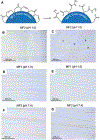Tunable Synthesis of Hydrogel Microfibers via Interfacial Tetrazine Ligation
- PMID: 35737940
- PMCID: PMC10410669
- DOI: 10.1021/acs.biomac.2c00504
Tunable Synthesis of Hydrogel Microfibers via Interfacial Tetrazine Ligation
Abstract
Crosslinked, degradable, and cell-adhesive hydrogel microfibers were synthesized via interfacial polymerization employing tetrazine ligation, an exceptionally fast bioorthogonal reaction between strained trans-cyclooctene (TCO) and s-tetrazine (Tz). A hydrophobic trisTCO crosslinker and homo-difunctional poly(ethylene glycol) (PEG)-based macromers with the tetrazine group conjugated to PEG via a stable carbamate (PEG-bisTz1) bond or a labile hydrazone (PEG-bisTz2) linkage were synthesized. After laying an ethyl acetate solution of trisTCO over an aqueous solution of bisTz macromers, mechanically robust microfibers were continuously pulled from the oil-water interface. The resultant microfibers exhibited comparable mechanical and thermal properties but different aqueous stability. Combining PEG-bisTz2 and PEG-bisTz3 with a dangling arginine-glycine-aspartic acid (RGD) peptide in the aqueous phase yielded degradable fibers that supported the attachment and growth of primary vocal fold fibroblasts. The degradable and cell-adhesive hydrogel microfibers are expected to find utility in a wide array of tissue engineering applications.
Figures










References
-
- Lutolf MP; Hubbell JA, Synthetic biomaterials as instructive extracellular microenvironments for morphogenesis in tissue engineering. Nat. Biotechnol 2005, 23 (1), 47–55. - PubMed
-
- Wang N; Butler JP; Ingber DE, Mechanotransduction across the cell surface and through the cytoskeleton. Science 1993, 260 (5111), 1124–1127. - PubMed
-
- Daley WP; Peters SB; Larsen M, Extracellular matrix dynamics in development and regenerative medicine. J. Cell Sci 2008, 121 (Pt 3), 255–264. - PubMed
-
- Kleinman HK; Philp D; Hoffman MP, Role of the extracellular matrix in morphogenesis. Curr. Opin. Biotechnol 2003, 14 (5), 526–532. - PubMed
-
- Giancotti FG; Ruoslahti E, Integrin signaling. Science 1999, 285 (5430), 1028–32. - PubMed
Publication types
MeSH terms
Substances
Grants and funding
LinkOut - more resources
Full Text Sources

